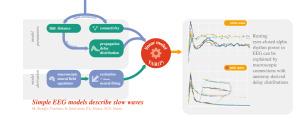头皮脑电慢波动力学可以用简单的远程连接统计模型来解释。
IF 4.5
2区 医学
Q1 NEUROIMAGING
引用次数: 0
摘要
头皮记录脑电图(EEG)被认为是由依赖于个体认知状态和任务的局部和全局振荡驱动的。然而,许多脑电图研究假设活动是局部的,特别是在对脑电图活动进行逆建模时。在这项工作中,我们展示了一个简单的纯宏观连接模型,该模型来源于远距离轴突延迟的生物学上合理的分布,可以驱动头皮记录的脑电图动力学的许多传统特征。所有需要的是一个简单的线性模型的时间延迟的线性向量自回归框架与几个参数。我们在模型中做了几个简化的建模假设:只包括远端兴奋性连接,局部活动作为随机噪声处理,忽略非线性突触动力学。作为概念验证,我们将模型限制在五个广泛的大脑区域(额叶、顶叶、枕叶、颞叶和丘脑),并在没有外部输入的情况下模拟静息状态脑电图。我们展示了这个简单的连接模型是如何从突触活动的理论原理中推导出来的。该模型能够复制真实脑电数据的许多特征,包括静息状态α功率和相干性(8-13 Hz)。我们表明,模型参数也可以通过fMRI BOLD测量的结构连通性,轴突直径估计和功能连通性的经验工作来告知。然而,宏观模拟的一些特征并不适合作为静息脑电图的所有特征的模型,例如与真实数据相反,模拟中的低频高相干性。总的来说,这些结果支持了对许多经典脑电图结果的解释,即宏观网络行为,而不是局部活动。本文章由计算机程序翻译,如有差异,请以英文原文为准。

Slow wave dynamics of scalp EEG can be explained by simple statistical models of long-range connections
Scalp-recorded electroencephalography (EEG) is thought to be driven by both local and global oscillations dependent on the cognitive state and task of the individual. However, many EEG studies assume that the activity is local, especially when inverse modeling EEG activity. In this work, we show that a simple model of purely macroscopic connections derived from biologically plausible distributions of long-range axon delays can drive many of the traditional features of scalp-recorded EEG dynamics. All that is required is a simple linear model of time delays in a linear vector autoregressive framework with a few parameters. We make several simplifying modeling assumptions in the model: only long-range excitatory connections are included, local activity is treated as stochastic noise, and nonlinear synaptic dynamics are omitted. As a proof of concept, we restrict the model to five broad brain regions (frontal, parietal, occipital, temporal, thalamic) and model resting state EEG with no external input. We show how this simple connection model is derived from theoretical principles of synaptic activity. The model is able to replicate many features of real EEG data, including resting-state alpha power and coherence (8–13 Hz). We show that model parameters can also be informed by empirical work on structural connectivity, axon diameter estimation, and functional connectivity of fMRI BOLD measures. However, some features of the macroscopic simulations are not ideal as a model for all features of resting EEG, such as high coherence in low-frequencies in the simulation as opposed to real data. Overall, the results support the explanation of many classical EEG findings in terms of macroscopic network behavior as opposed to local activity.
求助全文
通过发布文献求助,成功后即可免费获取论文全文。
去求助
来源期刊

NeuroImage
医学-核医学
CiteScore
11.30
自引率
10.50%
发文量
809
审稿时长
63 days
期刊介绍:
NeuroImage, a Journal of Brain Function provides a vehicle for communicating important advances in acquiring, analyzing, and modelling neuroimaging data and in applying these techniques to the study of structure-function and brain-behavior relationships. Though the emphasis is on the macroscopic level of human brain organization, meso-and microscopic neuroimaging across all species will be considered if informative for understanding the aforementioned relationships.
 求助内容:
求助内容: 应助结果提醒方式:
应助结果提醒方式:


